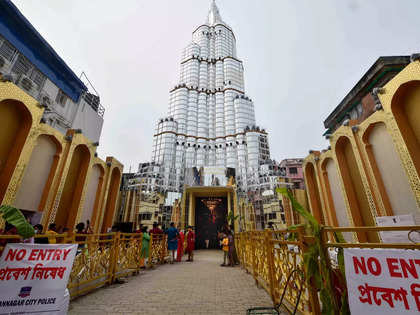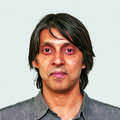 PTI
PTISo, what was this big attraction? The Victoria Memorial draped in a red-and gold Banarasi? A Hollywood actor or PM quoting, ‘Where the mind is without fear…’ to swooning Tagore bhakts? Nope. It was a pandal modelled on Dubai’s Burj Khalifa, the tallest building in the world.
Even if the pandal, 145 ft tall and made of 6,000 acrylic sheets, was as high and identical as the original 2,722 ft structure, people, it’s a replica. But the fact that it was a rip-off didn’t make it hohum dekhenge. In fact, quite the opposite. Public buses in Kolkata bore makeshift signs of ‘Burj Khalifa’ as their destination, plying tourist-pilgrims to a duplicate Dubai in the city of joy of second-hand worshippers.
Models of famous Bengal temples also crop up every Durga pujo, but without generating the kind of excitement the Burj pandal had this year. But a city largely built by aliens who departed Planet Kolkata nearly 80 years ago seems to have a special obsession with replicas of foreign originals.
Kolkata is also home to the duplicate Big Ben, officially named ‘Kolkata Time Zone,’ a permanent fibre-reinforced polymer 135-feet structure — mimicking the 316-feet limestone and cast-iron original in the ‘other city’ that posh Kolkatans ‘feel at home in’. All this, when buildings and structures are regularly crumbling or falling quicker than kids in the posh(er) parts can sing, ‘London Bridge is falling down, falling down, falling down…’
Earlier this month, a tumbledown house in Ahiritola in northern Kolkata did fall on the heads of a family living inside, killing three of its members, a child included. Of course, for aesthetes who don’t live in these neighbourhoods outside the peekaboos of Kolkata coffee-table books, postcards and exquisite English language essays, these are wonderful heritage structures invoking tropical versions of Tintern Abbey that need figurative, if not literal, support. But the fondness and value put to mimicry goes deeper than simply setting up structures to give some desperately seeking ‘world-class’ to a city and its people. Kolkata’s club culture, for instance, is a standup in the form of a self-standing ovation to mimicking early 20th century (white) pre-post-colonial twit-Brits with dress and language codes (Hindi and Bengali to bearers/beyaras, Wren & Martin-sanctified English to each other) and entry restrictions (‘Indians’ replaced by ‘ayahs, drivers’). It’s one big cosplay.
India’s love for mimicry also exists beyond its most mimicking city. TV comedy show audiences love mimics the most. The highest form of getting laughs here is ‘doing a Dharmendra, SRK or Modi’. Good impersonations are genuinely funny. And many comics do start their careers by getting noticed as mimicking others. But then, they move on. Here, it’s largely the glass ceiling. Like people loving cover bands for playing note-for-note of the original song, rather than giving their own twist to it. Coming back to phallic imitations, Las Vegas, too, has an Eiffel Tower and a Luxor Pyramid. But they are not the main draw like the Diet Burj. Other things are — the casinos, the shows, the stuff that ‘stays in Vegas after it happens in Vegas’. Over here, the forgery is considered more valuable than the original — ‘Wow, it’s exactlylike the original! Now that is genius!’ Valuing knock-offs are the effect of a culture that prefers cutting corners, finds it wasteful to come up with its own creations and inventions, rewards copying — whether of Uber, WhatsApp, Gucci, Burj Khalifa, songs, movies, designs — and looks at genuinely original homegrown things with suspicion, hostility and a memo that says, ‘But it’s not been tried and tested out anywhere yet!’
As in evolutionary biology, mimicry here is an anti-predator adaptation, a social mobility tool. If I look, behave, speak, and value or disparage things like people I consider to be superior, I am superior in my own backyard. After this logic, even Dubai looks dubious.










 Get Unlimited Access to The Economic Times
Get Unlimited Access to The Economic Times
